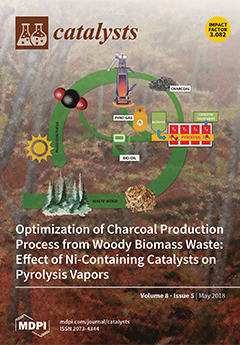The catalytic performances of Ru/ceria-based catalysts in the CO preferential oxidation (CO-PROX) reaction are discussed here. Specifically, the effect of the addition of different oxides to Ru/CeO
2 has been assessed. The Ru/CeO
2-MnO
x system showed the best performance in the 80–120 °C temperature range, advantageous for polymer-electrolyte membrane fuel cell (PEMFC) applications. Furthermore, the influence of the addition of different metals to this mixed oxide system has been evaluated. The bimetallic Ru–Pd/CeO
2-MnO
x catalyst exhibited the highest yield to CO
2 (75%) at 120 °C whereas the monometallic Ru/CeO
2-MnO
x sample was that one with the highest CO
2 yield (60%) at 100 °C. The characterization data (H
2-temperature programmed reduction (H
2-TPR), X-ray diffraction (XRD), N
2 adsorption-desorption, diffuse reflectance infrared Fourier transform spectroscopy (DRIFT), X-ray photoelectron spectroscopy (XPS)) pointed out that the co-presence of manganese oxide and ruthenium enhances the mobility/reactivity of surface ceria oxygens accounting for the good CO-PROX performance of this system. Reducible oxides as CeO
2 and MnO
x, in fact, play two important functions, namely weakening the CO adsorption on the metal active sites and providing additional sites for adsorption/activation of O
2, thus changing the mechanism from competitive Langmuir–Hinshelwood into non-competitive one-step dual site Langmuir–Hinshelwood/Mars–van Krevelen. As confirmed by H
2-TPR and XPS measurements, these features are boosted by the simultaneous presence of ruthenium and palladium. The strong reciprocal interaction of these metals between them and with the CeO
2-MnO
x support was assumed to be responsible of the promoted reducibility/reactivity of CeO
2 oxygens, thus resulting in the best CO-PROX efficiency at low temperature of the Ru-Pd/CeO
2-MnO
x catalyst. The higher selectivity to CO
2 found on the Ru–Pd system, which reduces the undesired H
2 consumption, represents a promising result of this research, being one of the key aims of the design of CO-PROX catalysts.
Full article





